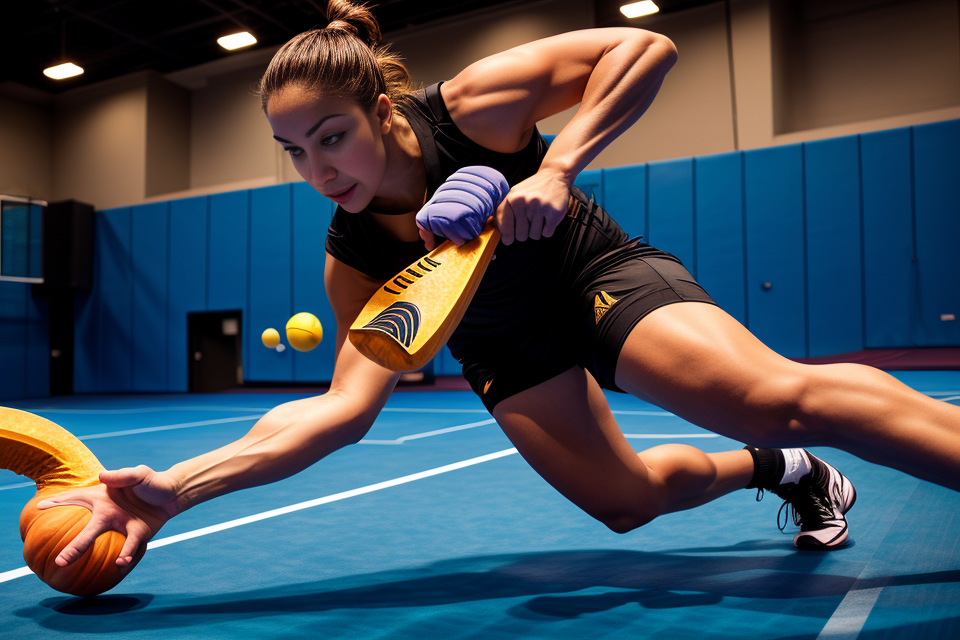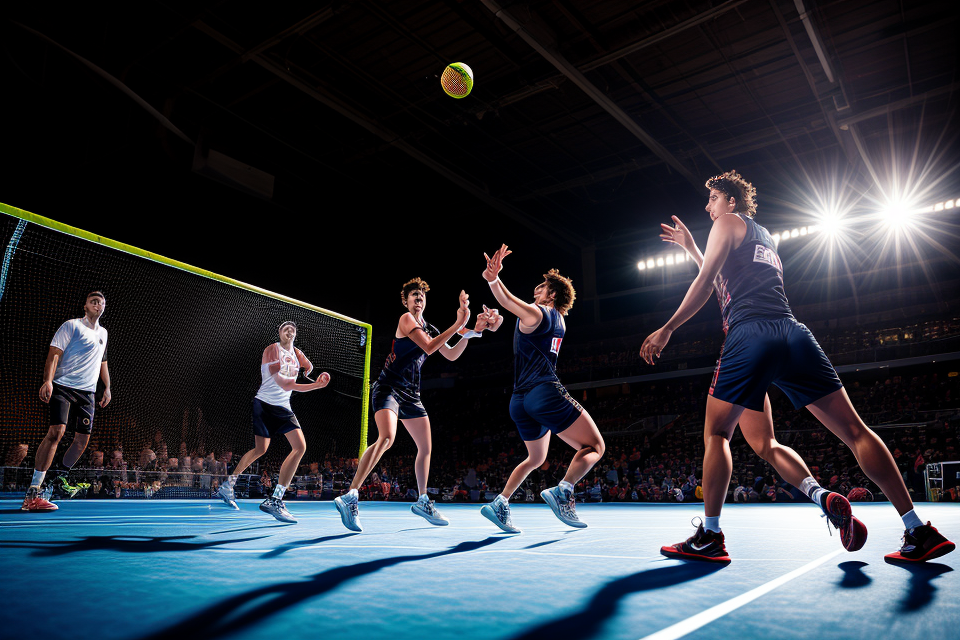Squash is a popular racket sport that is played by millions of people around the world. However, it is also a sport that can cause serious eye injuries if proper precautions are not taken. The eyes are one of the most sensitive parts of the body and any injury to them can be devastating. In this article, we will explore the frequency of eye injuries in squash and what can be done to prevent them. From wearing protective eyewear to warming up properly, there are several measures that players can take to keep their eyes safe while playing squash. So, let’s dive in and find out more!
Eye injuries are a common occurrence in squash, especially due to the speed and trajectory of the ball. They can range from minor scratches to more severe injuries such as retinal detachment. To prevent eye injuries, it is important to wear appropriate eye protection, such as sports goggles that are specifically designed for squash. Additionally, players should avoid blocking the ball with their face or eyes, and should instead use their racquet to block shots. It is also important to ensure that the squash court is well-lit and that the ball is in good condition to reduce the risk of injury. By taking these precautions, players can significantly reduce their risk of sustaining an eye injury while playing squash.
Understanding Squash Eye Injuries
Types of Eye Injuries in Squash
Squash is a sport that involves a small, dense ball and a racquet. The fast-paced and dynamic nature of the game makes it prone to eye injuries. In this section, we will discuss the different types of eye injuries that can occur in squash.
Corneal abrasions
Corneal abrasions are one of the most common eye injuries in squash. They occur when the surface of the eye is scratched, usually due to a blow from a racquet or a collision with another player. Symptoms of a corneal abrasion include pain, redness, and sensitivity to light. Treatment typically involves eye drops to help alleviate pain and prevent infection.
Hyphema
Hyphema is another common eye injury in squash. It occurs when blood collects in the front part of the eye, usually due to a blow to the eye or a collision with another player. Symptoms of hyphema include pain, redness, and the appearance of blood in the white part of the eye. Treatment typically involves eye drops to help alleviate pain and prevent infection, as well as observation to ensure that the blood does not cause any complications.
Retinal detachment
Retinal detachment is a more serious eye injury that can occur in squash. It occurs when the retina, the part of the eye that processes visual information, separates from the underlying tissue. Symptoms of retinal detachment include sudden, severe pain, vision loss, and flashes of light. Treatment typically involves surgery to reattach the retina.
Eyeball fractures
Eyeball fractures are rare in squash, but they can occur when the ball or a racquet strikes the eye with enough force to fracture the bones of the eye. Symptoms of an eyeball fracture include pain, swelling, and vision loss. Treatment typically involves surgery to repair the fracture and address any related damage to the eye.
Causes of Eye Injuries in Squash
Squash is a sport that requires rapid movement and precision, making it susceptible to eye injuries. Understanding the causes of eye injuries in squash can help prevent them. The following are some of the most common causes of eye injuries in squash:
- High-speed ball: Squash balls can travel at high speeds, up to 168 km/h, and can cause significant damage to the eyes if they come into contact with them. This is especially true for players who are not wearing proper eye protection.
- Direct impact from racquet or ball: The racquet or ball can hit the eye directly, causing serious injury. This can happen when a player is hit by a ball that has been hit with a lot of force or when a player is struck by a racquet while playing.
- Slipping or tripping: Squash courts can be slippery, and players may slip or trip, leading to eye injuries. This can happen when a player is running to make a shot and trips over a slippery spot on the court.
- Poor vision or uncorrected refractive errors: Players with poor vision or uncorrected refractive errors are at a higher risk of eye injuries in squash. This is because they may not be able to see the ball clearly, leading to mistakes that can result in eye injuries. It is important for players to get regular eye exams and wear corrective lenses if necessary.
By understanding the causes of eye injuries in squash, players can take steps to prevent them. Wearing proper eye protection, being aware of the court surface, and taking care of their vision can all help prevent eye injuries in squash.
Symptoms of Eye Injuries in Squash
Eye injuries are a common occurrence in squash, with players often experiencing a range of symptoms. These symptoms can vary in severity and may not appear immediately after the injury occurs. It is important for players to be aware of the potential symptoms of eye injuries in squash so that they can seek prompt medical attention if necessary.
One of the most common symptoms of an eye injury in squash is pain. This pain may be felt in the eye itself or in the surrounding area, and can range from a dull ache to a sharp stabbing sensation. In some cases, the pain may be accompanied by other symptoms such as blurred vision or sensitivity to light.
Blurred vision is another common symptom of an eye injury in squash. This can occur if the injury causes damage to the cornea or lens of the eye, which can affect the way that light is focused. Double vision, or diplopia, is another symptom that may occur if the injury affects the alignment of the eyes.
Light sensitivity, or photophobia, is another symptom that may occur after an eye injury in squash. This can manifest as a feeling of discomfort or pain when exposed to bright lights, or as a sensitivity to glare.
Finally, eye swelling or bruising may occur after an eye injury in squash. This can be a sign of more serious damage to the eye, and should be evaluated by a medical professional as soon as possible.
Preventing Eye Injuries in Squash
Proper Eye Protection
Eye injuries are a common occurrence in squash, with players being at risk of injury from balls traveling at high speeds, as well as from racquet and court accidents. To prevent these injuries, it is essential to wear proper eye protection. Here are some guidelines for wearing sports goggles or glasses with polycarbonate lenses:
- Wearing sports goggles or glasses with polycarbonate lenses: Polycarbonate lenses are the best choice for sports eyewear because they are lightweight, shatterproof, and provide excellent protection against impact. Sports goggles are designed specifically for squash and offer a secure fit that will not be dislodged during play. They also have foam padding that helps to reduce the impact of a ball or racquet hit.
- Ensuring proper fit and comfort: The eyewear should fit snugly and comfortably around the player’s head, with no gaps or loose spots. It should also be easy to adjust the straps so that the goggles do not move around during play. The frame should also be lightweight and flexible, so it can bend without breaking.
- Replacing eyewear after impact: If the eyewear is damaged or has been hit by a ball, it should be replaced immediately. Even if the eyewear appears to be undamaged, it may have been weakened and could fail during a future impact. It is better to replace the eyewear to ensure that it will provide the necessary protection.
By following these guidelines, players can significantly reduce their risk of eye injuries while playing squash. It is essential to remember that proper eye protection is the most effective way to prevent eye injuries and ensure that players can continue to enjoy the sport without risking their vision.
Warm-Up and Stretching
Eye injuries in squash can be caused by a variety of factors, including physical impact, rapid movement, and exposure to foreign objects. One of the most effective ways to prevent these injuries is through proper warm-up and stretching exercises. Here are some key points to consider:
- Focusing on eye muscles: The muscles around the eyes are responsible for focusing, blinking, and maintaining proper eye alignment. By incorporating exercises that target these muscles into your warm-up routine, you can help to improve your overall eye health and reduce your risk of injury.
- Increasing blood flow to the eyes: Good blood circulation is essential for maintaining healthy eyes. During your warm-up, you can increase blood flow to your eyes by performing exercises that encourage blood circulation throughout your body. This can include jumping jacks, jogging, or other cardiovascular exercises.
- Reducing risk of injury: By incorporating proper warm-up and stretching exercises into your routine, you can help to reduce your risk of eye injuries in squash. This can include stretching your neck and shoulders, which can help to prevent strain and injury to the muscles around your eyes.
It’s important to remember that warm-up and stretching exercises should be tailored to your individual needs and abilities. If you have any existing eye conditions or concerns, it’s always a good idea to consult with a healthcare professional before beginning any new exercise routine.
Court Safety
When it comes to preventing eye injuries in squash, court safety is a crucial aspect to consider. Here are some tips to ensure the court is safe for play:
- Making sure the court is clear before playing: Before starting a game, it’s important to check that the court is clear of any obstacles or debris. This includes making sure there are no balls, rackets, or other equipment on the court that could cause injuries.
- Wearing non-slip shoes: Squash courts can be slippery, especially when they are wet or sweaty. Wearing non-slip shoes can help prevent slips and falls, which can result in eye injuries.
- Keeping the court clean and free of debris: During the game, it’s important to keep the court clean and free of debris. This means picking up any balls that go out of bounds and making sure there are no rackets or other equipment on the court. Additionally, players should avoid touching the walls or floor of the court with their hands, as this can also cause debris to accumulate.
By following these court safety tips, players can significantly reduce their risk of eye injuries while playing squash.
Proper Technique
Proper technique is crucial in preventing eye injuries in squash. By following the correct methods, players can significantly reduce the risk of sustaining an eye injury. Here are some of the essential techniques to employ:
- Using a correct grip on the racquet: The grip is the foundation of proper squash technique. A correct grip ensures that the racquet is held in a way that allows for efficient movement and control. A good grip should be comfortable, stable, and allow for a smooth swing.
- Avoiding extreme movements or sudden changes in direction: Squash is a fast-paced game that requires quick movements and changes in direction. However, it is essential to avoid extreme movements or sudden changes that can lead to accidents and eye injuries. Players should always be aware of their surroundings and plan their movements accordingly.
- Learning proper squash techniques to reduce the risk of injury: Learning proper squash techniques can help reduce the risk of eye injuries. Players should focus on developing proper footwork, strokes, and movement patterns. This includes learning how to properly position themselves on the court, how to move efficiently, and how to hit the ball with accuracy and power.
By following these proper techniques, players can significantly reduce the risk of eye injuries in squash. It is important to remember that prevention is always better than treatment, and by taking the necessary precautions, players can enjoy the game without the fear of sustaining an eye injury.
Medical Attention
Seeking immediate medical attention for any eye injuries is crucial to prevent further damage and ensure proper healing. The following steps should be taken when an eye injury occurs during squash:
- Seeking immediate medical attention: If an eye injury occurs during a squash game, it is important to seek immediate medical attention. Delaying treatment can result in permanent vision loss or other complications.
- Following doctor’s orders for treatment and recovery: Once at the hospital or clinic, the doctor will provide a treatment plan and instructions for recovery. It is important to follow these instructions carefully and as directed.
- Informing the doctor of any recent squash activities for proper guidance: It is important to inform the doctor of any recent squash activities when seeking treatment for an eye injury. This information will help the doctor provide the most appropriate treatment and guidance for recovery.
In addition to seeking medical attention, it is also important to protect the injured eye from further injury. This may involve using an eye patch or other protective measures to prevent further damage. It is also important to avoid rubbing or applying pressure to the injured eye, as this can worsen the injury.
Overall, seeking immediate medical attention for any eye injuries is crucial to prevent further damage and ensure proper healing. Following the doctor’s instructions and protecting the injured eye can help prevent long-term vision loss and other complications.
FAQs
1. How common are eye injuries in squash?
Eye injuries are relatively common in squash, particularly among players who have not adequately protected their eyes while playing. The risk of eye injury is higher in squash than in other racket sports, due to the close proximity of the ball to the player’s face. Studies have shown that up to 90% of eye injuries in squash are caused by the ball hitting the eye or eyebrow.
2. What are the most common types of eye injuries in squash?
The most common types of eye injuries in squash are abrasions, contusions, and hyphema (bleeding in the eye). These injuries can range from mild to severe and can result in pain, vision loss, and even permanent eye damage.
3. What are the causes of eye injuries in squash?
Eye injuries in squash can be caused by a variety of factors, including being hit by the squash ball, accidental eye pokes, and even being hit by the racquet. Poor eye protection, lack of awareness, and inadequate training can also contribute to the risk of eye injury.
4. How can I prevent eye injuries while playing squash?
To prevent eye injuries while playing squash, it is important to wear appropriate eye protection. This can include wearing goggles or a face mask that covers the eyes, as well as being aware of your surroundings and paying attention to the ball at all times. It is also important to keep your eye protection clean and in good condition, and to replace it if it becomes damaged.
5. What should I do if I experience an eye injury while playing squash?
If you experience an eye injury while playing squash, it is important to seek medical attention immediately. You should also avoid rubbing or pressing on the injured eye, as this can cause further damage. If the injury is severe, you should go to the emergency room or an eye clinic for treatment. In any case, it is important to seek medical attention promptly to prevent permanent eye damage.










